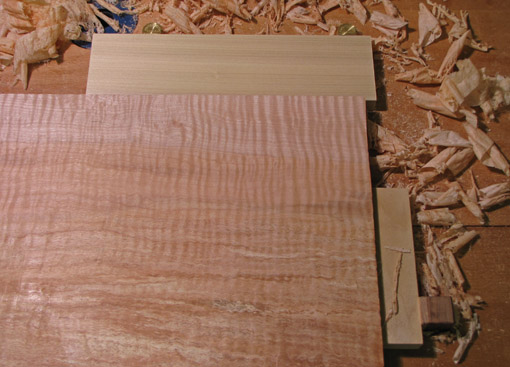
As discussed in the previous post, one of the keys to successful work with the jack plane is the use of a vigorous diagonal stroke. To stabilize the board from the pressure in multiple directions, I like to use Veritas Bench Pups, Bench Anchors, and Wonder Pups in various configurations, usually along with regular bench dogs, as shown in the photo above. Other options for use of these handy devices and shop-made stops at the right and left sides of the workbench are discussed in these two earlier posts.
Beware when planing thin boards, say under ½”, which can flex. It may be necessary, for example, to place shims, such as blue tape or veneer, under a convex surface facing the bench for a similar reason that you would not place a non-flat surface on a thickness planer machine bed. Likewise, it is often necessary to place shims under the high corners of a twisted board.
To set the blade projection, I use these steps: I sight from the front of the sole, with light adjusted to reflect off the thin flat at the rear of the mouth (I file that flat when I set up a new plane). I advance the blade enough to see it to correct the lateral adjustment, then back off the projection to a minimal amount. I start stroking the plane on the wood, back and forth, gradually advancing the blade, often using my left hand on the feed screw and my right on the tote. I’ve found this method gives better results than using sight alone, or running a narrow scrap against the blade.
The long infeed length of the Veritas BU jack makes it feel almost like a jointer. It’s easy and natural to move the plane back and forth rapidly without lifting it, like scrubbing the wood. This gives excellent tactile feedback to be able to sense when the surface is approaching flatness.
The Veritas BU jack has some other nice features. The lack of a cap iron (“chipbreaker”) makes swapping blades very easy. I find the little set screws on each side of the plane near the mouth help to quickly position the new blade. The mouth opening can be adjusted in seconds to accommodate different shaving thicknesses. This is far easier than adjusting the frog on a bevel-down plane. I also like the Norris-type combined feed and lateral adjustment mechanism, though some woodworkers do not.
I strongly suggest getting rid of the awful handles that Veritas puts on their planes and get a set from Bill Rittner – I think you will find that they dramatically improve the feel of the plane.
These features make the Veritas BU a good choice for your workhorse jack plane. That said, I also have a 30-year-old Record #5. They each have their advantages, I use both of them regularly, and will not be parting with either. If you want me to declare a winner, I can only say that there’s more than one good way to do most everything in woodworking. I hope these posts will help you find your way.
[These endorsements are unsolicited and uncompensated.]

One of the touted advantages of a bevel-up plane is the ability to easily change the cutting angle simply by changing the primary bevel on the iron. Do you plan on doing any experimenting like that?
Steve,
I’ve tried higher sharpening angles for BU jack blades and they are just not worth it. The plane is too hard to push, other problems arise as described in the posts, and they are just not necessary. The BU smoother is a different matter, and there I do keep a blade for it sharpened at 48° and find it is helpful for figured woods prone to tearout.
Rob